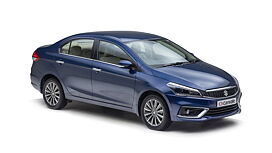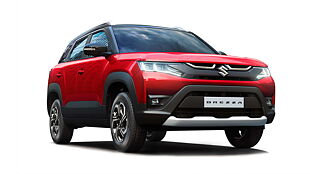Introduction

The comprehensively updated Hyundai Verna is the newest car in the C-segment currently. Hyundai has revamped the sedan with newer styling and a rejigged powertrain along with an updated interior. However, this segment generally witnesses a three-way battle between the Verna, City and Maruti Suzuki’s Ciaz. So as we wait for the new-gen Honda City to come around, let us take a look at the cabin space on offer between the other two sedans and see which one you should consider if interior space tops your buying criteria.
Front cabin space

Where the Maruti makes use of light-coloured materials for the interior, the Verna now also gets an all-black cabin (in the Turbo trim). Otherwise, the dual-tone interior in both feels modern and well laid out. There are wooden inserts in the Ciaz, while Verna gets a newer touchscreen and wireless charging feature. The Ciaz’s wider cabin offers more shoulder room at 1310mm than what you get in the Verna (1250mm).

Also, the Ciaz has an old-school dual-analogue instrument cluster, while Verna now offers all-digital screen too. Seats in both cars get height-adjust and ample lateral and bolstering support. But the Verna also offers a cooling function. So for more space, Ciaz wins the round, but tech-savvy buyers might have to go for the Verna.
| Front | Hyundai Verna | Maruti Suzuki Ciaz |
| Legroom (Max/min) | 840/630mm | 840/600mm |
| Ideal legroom (77 back) | 660mm | 820mm |
| Headroom(Max/min) | 930/870mm | 920mm |
| Shoulder room | 1270mm | 1310mm |
| Seat base length | 500mm | 520mm |
| Backrest height | 630mm | 620mm |
| Ingress | 570mm | 630mm |
Rear cabin space

Here is where the Ciaz takes home the crown offering an unmatched legroom. Its 990/800mm of legroom is segment-best and much more than the Verna’s 870/630mm. Even the shoulder room of 135mm is much more than the 1280mm you get in the Hyundai. Moreover, the seats in the Ciaz are slightly larger and that helps it in adding more sense of space too. Both the cars have a high window line, but Verna’s coupe-like roofline makes the window slightly smaller and narrower than the Ciaz’s quarter window. There are amenities like rear AC vents, 12V power supply and electric windows in both the cars. The Ciaz also has higher ingress and slightly wider and lower door, so elderly passengers can get in and out with ease.

| Rear | Hyundai Verna | Maruti Suzuki Ciaz |
| Legroom (Max/min) | 810/580mm | 990/800mm |
| Ideal legroom (100 front) | 670mm | 800mm |
| Headroom | 870mm | 900mm |
| Shoulder room | 1240mm | 1350mm |
| Seat base length | 480mm | 480mm |
| Backrest height | 700mm | 630mm |
| Ingress | 590mm | 620mm |
Boot Space

Another segment-best feature in the Ciaz is the boot space of more than 500 litres. But it doesn’t mean Verna’s boot is undersized by any standards. It still is large enough to gulp down one large suitcase and a couple of small ones with ample room to spare for duffle bags and bag packs. However, neither car’s boot is squared-off and has intrusive wheel arches eating up space.

| Boot | Hyundai Verna | Maruti Suzuki Ciaz |
| Length/width/height | 1010/1100/460mm | 1000/1380/600mm |
| Loading lip height | 720mm | 760mm |
| Loading lid height | 1690mm | 1740mm |
Conclusion

Both the Maruti Suzuki Ciaz and Hyundai Verna are superb products in their own rights. Although the Ciaz has an upper hand when it comes to space, the Verna fights back by offering more features which the Maruti misses out on considerably. So if cabin space is your primary criteria, the Ciaz makes the most viable buy, otherwise, the Verna comes as a well-rounded package.

Photos by Kapil Angane

























